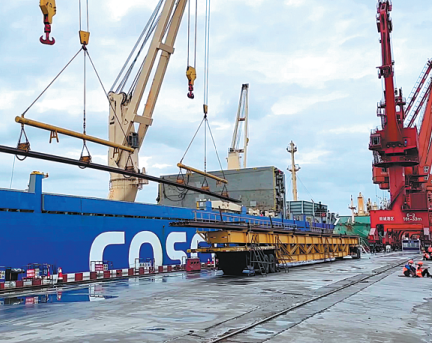China ships last batch of rails for Indonesian high-speed train project

Steel rails are unloaded from a vehicle onto a ship at Fangchenggang Port, Guangxi Zhuang autonomous region. CHINA DAILY
The last batch of steel rails for the construction of Indonesia's Jakarta-Bandung High Speed Railway left from a port in southeastern China for Indonesia last month.
The cargo, which weighed 5,550 metric tons, was transported to Fangchenggang Port in the Guangxi Zhuang autonomous region by rail and then loaded onto an Indonesia-bound vessel.
Once completed, the 142-kilometer line will be the first in Southeast Asia capable of handling trains traveling at speeds of up to 350 kilometers per hour. It will cut travel time between the national capital, Jakarta, and Bandung, the capital of West Java province, from more than three hours to just 40 minutes.
Construction on the line began in 2018. Manufactured by a company in Panzhihua in Sichuan province, the rails have taken 16 months to complete, with the first batch sent to Indonesia in April last year.
Both railway and port operators strictly monitored and controlled the process of loading and unloading, ensuring the shipments left on time, according to the Nanning Railway Group.
A key part of the rail project-the No 10 tunnel in Bandung-was completed last month, marking a major breakthrough, according to the China Railway Design Corp.
Digging of the 1,230-meter-long tunnel began in March 2019. It faced a number of technical challenges, among them the high content of volcanic ash in the soil and the presence of rice fields above the tunnel's intended route.
Another high-risk part of the project, the erection of box girders, was also completed last month.
A statement released by KCIC, the joint venture consortium between the Chinese and Indonesian state-owned companies that run the railway, said the Chinese companies responsible for construction carried out their work at nights safely and efficiently, and they caused little disruption to passengers and freight trains during the day.
They also steadily advanced construction while ensuring the staff's health and safety during the COVID-19 pandemic.
